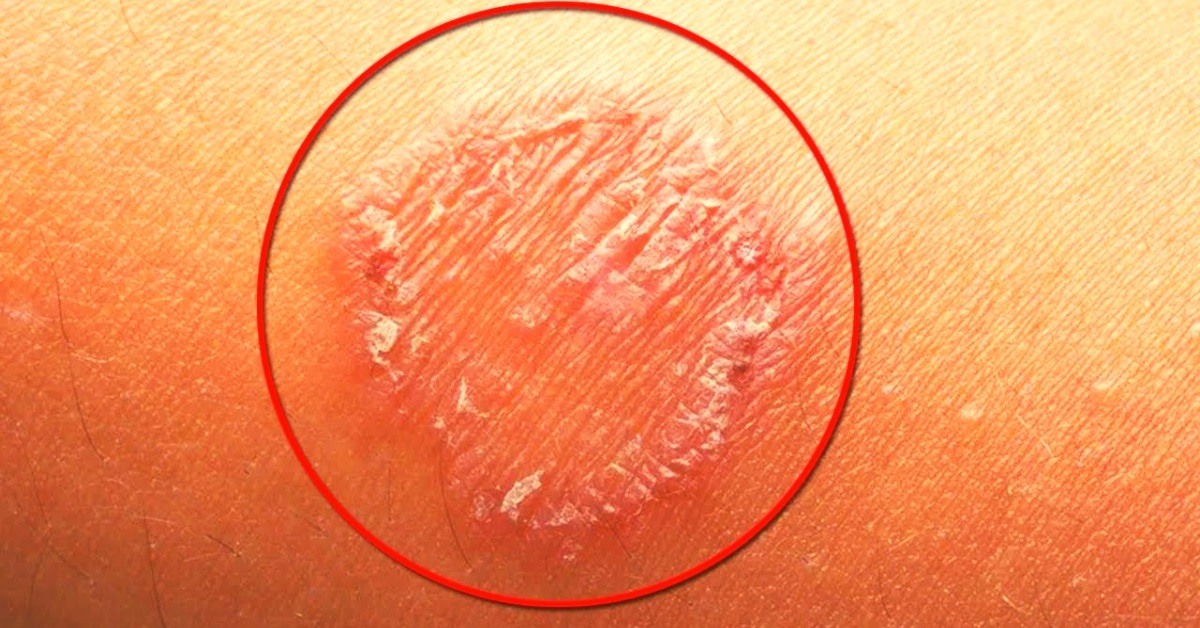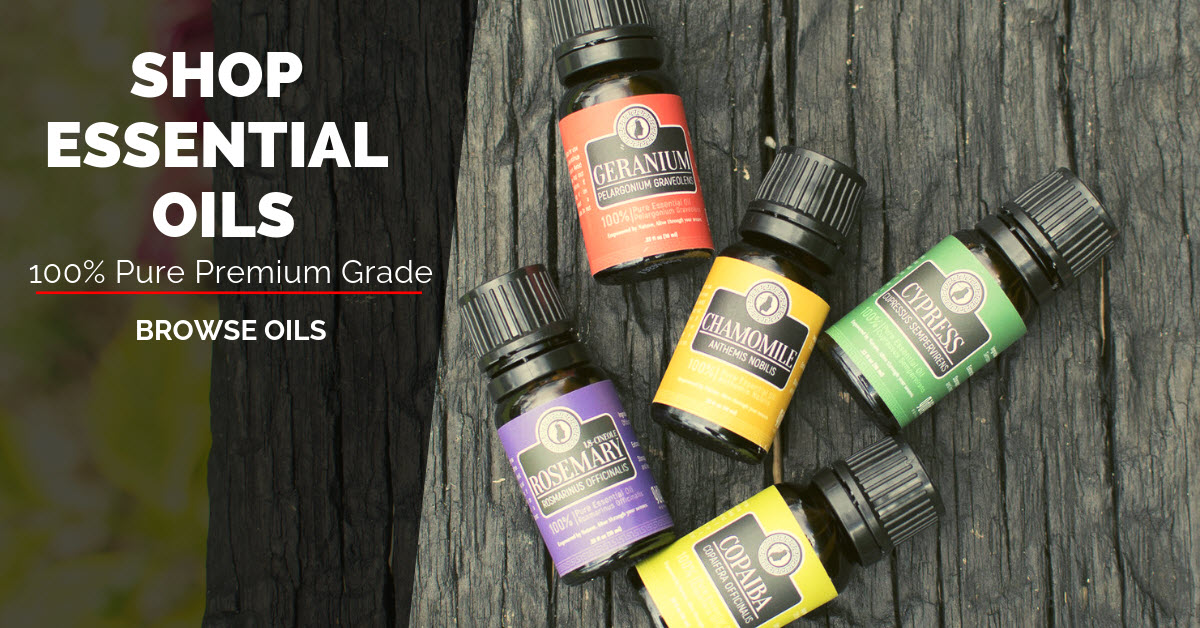Contrary to what many people believe, ringworm isn’t a skin infection caused by worms. It’s a fungal infection caused by the fungi: trichophyton, epidermophyton, and microsporum. These fungi, having the ability to live for prolonged periods, attach themselves to a host upon contact.
Ringworm, also called dermatophytosis, create ring-like, inflamed patches on the skin. While initially affecting localised dermal areas, they can spread throughout the body. This fungal infection may affect the scalp (tinea capitis), the body (tinea corporis), the groin (jock itch), and the feet (athlete’s foot). Animals and humans can contract and spread the fungal infection.
Why Essential Oils Are Good For Ringworm
The natural components of selected essential oils have a strong impact on the fungi that cause ringworm. These natural components work against the development, growth, and spreading of the fungi.
These volatile oils are also safe to use, as they aren’t accompanied by the same side effects of conventional ringworm treatments. Medications with synthetic ingredients, when applied topically, may have adverse effects on the skin. As the contents of the administered cream is too strong, some users encounter unfavorable skin reactions. The cream could burn the skin, leaving dark or discolored patches in areas where it has been applied.
7 Best Essential Oils For Ringworm
Essential oils boasting antifungal and antimycotic actions are best used against the fungi that cause ringworm.
1. Lavender Essential Oil (Lavandula angustifolia)
While the components of lavender produce antifungal activities, the extract did not score a place in this article for that reason. It is, however, highlighted because of its relaxing and soothing properties. Ringworms have the tendency to cause itchiness, especially at nights. This often cause irritability and insomnia.
Lavender may be applied to affected areas to soothe and calm itchiness. Add 3 drops of lavender in a teaspoon of sweet almond oil and apply to infected areas with a cotton bud. An alternative is to disperse 2 tablespoons of milk and 5 drops of lavender and use as a bath oil.
Best for: Itchiness
2. Lemongrass Essential Oil (Cymbopogon citratus)
The limonene and citral content of lemongrass produces an antimicrobial agent. Lemongrass is particularly useful against athlete’s foot. If you’re someone who frequently goes without proper footwear on locker room floors, public pools, or even share items such as socks and shoes, you’re likely to pick up athlete’s foot.
Lemongrass can be used as a massage oil to work to inhibit growth and spreading of ringworm of the feet. Combine 3 drops of lemongrass in a teaspoon of neem oil and apply to the feet at least twice daily. Add a bit of lemongrass when washing socks to prevent spreading.
Best for: athlete’s foot
3. Clove Bud Essential Oil (Syzygium aromaticum)
The spicy-earthy undertone of clove might be easy on the nose, but the extract is tough on ringworm. Studies involving clove revealed the beauty of the oil. Volatile vapor of clove prevented the growth and reproduction of fungi, while direct application destroyed the fungi.
Clove is more potent with direct application. Add 10 to 15 drops of clove to a 60 ml ointment base and apply to infected area. Another alternative is to integrate clove into your daily skin regimen. Combine 9 drops of clove in 3 tablespoons of coconut oil. Apply twice daily to the skin.
Best for: ringworm of the body
4. Tea Tree Essential (Melaleuca alternifolia)
You’re not the only victim of ringworm; your pets are too. Once your snuggly pet has the skin infection, it can spread in no time. A clinical trial using tea tree showed strong antimicrobial activities against the trichophyton fungus in horses. Use it on your pets to provide relief. Otherwise, use the extract on your scalp.
To administer, add 5 to 8 drops of tea tree to your dog’s shampoo and use during your dog’s wash time. If you suffer from tinea capitis, ringworm of the scalp, add tea tree to your shampoo and use it to wash your hair at least 2 times each week.
Best for: ringworm of the scalp (tinea capitis)
5. Rosemary Essential Oil (Rosmarinus officinalis)
Components such as a-pinene, 1,8 cineole, and y-terpinene gives rosemary that wow factor to limit fungal growth. As ringworm fungi can survive for an extended period of time, it might stick around even after initial treatment. In some cases, you may also relapse into an infection. Rosemary is a strong cleanser that can be used to prevent further growth.
To your diffuser or vaporizer, add 6 drops of rosemary and allow it to cleanse the air. Ringworm spores can continue living on bedding, clothes, and other frequented areas. Using rosemary in a diffuser or spray may help prevent further growth and stop the infection from spreading. You can also add a few drops of the oil to your laundry.
Best for: inhibiting ringworm spores
6. Peppermint Essential Oil (Mentha piperita)
Peppermint has a nice, floral aroma with a minty undertone. Although it is an antifungal agent, it can be especially useful because of the ‘coolness’ it offers. Ringworm rashes do enlarge and form ugly clusters of patches in localized areas. This may incite gruesome itchiness and red unattractive rings on the skin.
The soothing, minty effect of peppermint can cool the area, minimizing itchiness and redness. Use as a cooling massage oil by adding 2 drops of peppermint into a teaspoon of almond oil. Massage directly on ringworm clusters for a minty feel.
Best for: dermal itchiness and irritation
7. Geranium Essential Oil (Pelargonium graveolens)
The main components of geranium, citronella and geraniol, were tested against the ringworm fungus to substantiate its effectiveness. When combined with another antifungal treatment, geranium “minimize the side-effects of ketoconazole” (a substance used for treating fungal infections). But, the extract has a two-fold benefit. It may also help relieve pain associated with a terrible ringworm case.
Apply geranium solution directly to ringworm patches to soothe irritated skin. In a teaspoon of almond oil, add 3 to 5 drops of geranium. Administer the oil directly to ringworm using the index finger and massage in a clockwise motion.
Best for: Inflamed or painful ringworm
3 Best Essential Oils For Ringworm Recipes
Powerful Foot Rub Blend For Athlete’s Foot
You don’t want to spend your waking hours itching away at your feet. This could cause lacerations, even encouraging the fungal infection to spread to other areas of the body. This recommended blend not only helps to kill the fungus, but it prevents it from spreading. The oils suggested to create this blend all produce an antifungal impact because of their components.
This blend makes at least 30 ml.
- 2 tablespoons neem oil
- 5 drops tea tree
- 4 drops geranium
- 2 drops lavender
Add the ingredients above in a bowl and mix well to combine together.
Pour the contents from the bowl into a clean euro-dropper bottle for safe keeping.
When ready to use, add a few drops of the blend into your palm and massage unto the feet. This ‘powerful blend for athlete’s foot’ is best applied on clean feet. It’s best to use after jumping straight out of the shower.
Minty Peppermint Hair Rinse For Ringworm Of The Scalp (Tinea Capitis)
Constant itchy scalp is annoying, but that’s nothing compared to a longstanding repercussion of ringworm of the scalp. The fungal infection may leave baldness in its wake. Hair surrounding the infected area may fall off. This is unattractive, especially if you’re young and in your prime.
This minty peppermint hair rinse blend is just the relief your beautiful hair needs. The essential oils recommended has a soothing and antifungal effect when applied to the scalp. The dry herb combination also reinforces the beauty and effectiveness of the blend.
Blend should make at least 45 ml.
- 1 tablespoon dried peppermint
- 1 tablespoon dried rosemary.
- 1 tablespoon cider vinegar
- 2 drops rosemary
- 2 drops peppermint oil.
Make an infusion by adding all the dried herbs in a pot of hot water (200 ml). Strain after leaving for 10 minutes.
Combine the essential oils and cider vinegar with the herbal infused water. Use as a final rinse after you’ve shampooed with warm, bearable water.
Cleansing Body Massage Blend For Ringworm On The Body (Tinea Corporis)
Ringworm may affect areas of your body including shoulders, legs, and back. These may be hard to reach places, and you won’t always spot a single ringworm patch to treat. This ‘cleansing body massage blend’ works to fix that. Instead of using your routine skin moisturiser, use this as a substitute.
- 10 drops clove
- 10 drops lemongrass
- 6 drops lavender
- 10 drops rosemary.
- 4 tablespoons coconut oil.
Combine all the essential oils into a sealed, dark bottle. The bottle should provide ease of access when pouring out the oils. Shake well and let it sit for about 10 minutes.
Add your diluent, coconut oil, to the essential oil blend. Shake well to combine.
Use twice daily as a moisturiser after showering, preferably in the mornings and nights. Remake the blend as you see fit.
To Summarize
- Ringworm is a fungal infection that affects the skin. It can be contracted through contact with humans, animals, or things with the fungi.
- Essential oils are potent forces against ringworm because of the antifungal action they provide.
- Essential oils such as lavender, lemongrass, clove, tea tree, rosemary, peppermint, and geranium can be used against ringworm.
- The ideal blend of essential oils not only provide a soothing effect on ringworm, but may prevent further spreading.
- Essential oil blends with strong antifungal and antimycotic properties work best against ringworm.
Read more:


